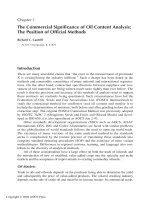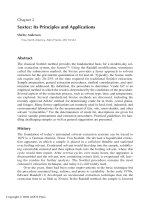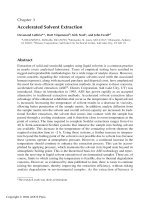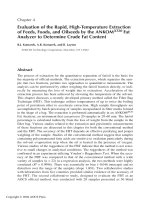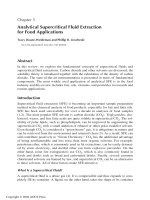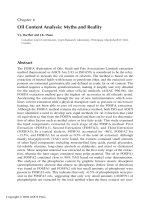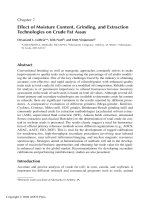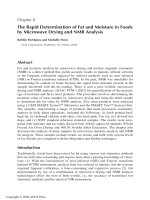oil extraction and analysis phần 3 docx
Bạn đang xem bản rút gọn của tài liệu. Xem và tải ngay bản đầy đủ của tài liệu tại đây (485.95 KB, 14 trang )
Chapter 3
Accelerated Solvent Extraction
Devanand Luthria
a,
*, Dutt Vinjamoori
b
, Kirk Noel
c
, and John Ezzell
d
a
USDA/ARS/FCL, Beltsville, MD 20705;
b
Monsanto, St. Louis, MO 63167;
c
Monsanto, Ankeny,
IA 50021;
d
Dionex Corporation, Salt Lake City Technical Center, Salt Lake City, UT 84119
Abstract
Extraction of solid and semisolid samples using liquid solvents is a common practice
in nearly every analytical laboratory. Years of empirical testing have resulted in
rugged and reproducible methodologies for a wide range of analyte classes. However,
recent concerns regarding the volumes of organic solvents used (with the associated
human exposure), along with increased purchase and disposal costs, have emphasized
the need for more efficient sample extraction methods. In response to these concerns,
accelerated solvent extraction (ASE
®
, Dionex Corporation, Salt Lake City, UT) was
introduced. Since its introduction in 1995, ASE has grown rapidly as an accepted
alternative to traditional extraction methods. Accelerated solvent extraction takes
advantage of the enhanced solubilities that occur as the temperature of a liquid solvent
is increased. Increasing the temperature of solvent results in a decrease in viscosity,
allowing better penetration of the sample matrix. In addition, analyte diffusion from
the sample matrix into the solvent and overall solvent capacity are increased. In tradi-
tional Soxhlet extraction, the solvent that comes into contact with the sample has
passed through a cooling condenser, and is therefore close to room temperature at the
point of contact. The time required to complete Soxhlet extractions ranges from 6 to
48 h. Semi-automated Soxhlet systems that immerse the sample into boiling solvent
are available. This increase in the temperature of the contacting solvent shortens the
required extraction time to ~2 h. Using these systems, a further increase in tempera-
ture beyond the boiling point of the solvent is not possible due to solvent loss because
these systems operate at atmospheric pressure. However, a continued increase in the
temperature should continue to enhance the extraction process. This can be accom-
plished by applying pressure, which maintains the solvent in its liquid state beyond its
atmospheric boiling point. This is the theoretical basis for ASE technology and repre-
sents the next step in liquid solvent extraction of environmental samples. There are, of
course, limits to which raising the temperature is feasible, due to thermal degradation
concerns. However, as evidenced by data published to date, there is room to continue
raising the temperature, thereby improving the extraction efficiency, without risking
analyte degradation in environmental samples. As the extraction efficiency is
*The research work was done at Monsanto.
Copyright © 2004 AOCS Press
increased, the time required to perform extractions and the amount of solvent needed
is reduced. When performing ASE, a 10-g sample can be extracted in ~12 min using
12–15 mL of solvent. As the sample size is increased (33 mL volume maximum), the
amount of solvent used increases proportionally (45–50 mL maximum), but the total
extraction time remains unchanged. The short extraction times and small solvent usage
make this technique amenable to automation. Samples loaded into stainless steel
extraction vessels (11, 22, or 33 mL internal volume) are extracted sequentially into
standard 40- or 60-mL glass collection vials. After extraction, the spent sample
remains in the cell, whereas the extract is immediately ready for processing. The sys-
tem is designed to extract up to 24 samples unattended. Because existing solvent-based
extraction methods can be readily transferred to ASE technology, methods develop-
ment is greatly simplified. Existing sample preparation and postextraction processing
steps remain in place because the extracts generated by ASE will be of very nearly the
same composition as those generated with the existing solvent-based extraction tech-
nique. The large range of polarities and solvent strengths available when using liquid
solvents, including solvent mixtures, allows a high degree of flexibility and selectivity
when developing methods for new sample matrices.
Introduction
Accelerated solvent extraction (ASE), also referred to as pressurized fluid extrac-
tion (PFE) and pressurized liquid extraction (PLE), is a liquid solvent extraction
technique that uses aqueous and organic extraction solvents at elevated tempera-
tures and pressures. Although the initial applications focus of this technique was
the environmental area, the versatility and ease of use of the approach have proven
useful for laboratories performing extractions in the food and polymer industries,
as well as in the pharmaceutical and consumer products areas.
Traditional reflux-based extraction techniques such as Soxhlet extraction can
take from 4 to 48 hour to perform, and 24-h extractions are common. Other liquid
solvent-based extraction techniques such as wrist shaker, hot plate boiling, and
sonication require copious amounts of solvent and often involve extensive labor
steps such as filtering or concentration before extract analysis. One thing that they
all have in common is operation at ambient pressure. An increase in temperature
beyond the boiling point of the solvent is not possible due to solvent evaporation.
Accelerated solvent extraction is performed by using the same solvents as in the
traditional approaches, but at higher temperatures than is possible in these techniques.
This increase in temperature improves the kinetics of the process, resulting in more
efficient extractions (faster and using less solvent) compared with traditional approach-
es. The solvents are used under pressure so that their liquid state is maintained under
heated conditions. For example, solvents such as water, methanol, acetone, or hexane
are routinely used in ASE at temperatures ranging from 75 to 150°C. The solvents are
maintained as liquids under pressure, normally at 1500 psi (10.4 MPa). ASE is per-
formed, therefore, using very hot liquids to expedite the extraction process.
Copyright © 2004 AOCS Press
The flow-through design of the technique results in extracts that do not require
the extended labor of filtration as a means of separating the sample matrix from the
extracted analytes. In further contrast to traditional extraction approaches, all of the
basic steps are amenable to automation, freeing the analyst from the labor-inten-
sive nature of most sample preparation protocols. Automated ASE systems can
extract up to 24 sample cells, and have built in the necessary safety considerations
for unattended operation.
Instrumentation
A schematic diagram of an ASE system is shown in Figure 3.1. The extraction proce-
dure consists of a combination of dynamic and static flow of the solvent through a
heated extraction cell containing the sample. These cells must be capable of safely
withstanding the pressure requirements of the system, and are normally constructed of
stainless steel, with frits in the end caps to allow the passage of solvent while maintain-
ing the solid sample within. Cell sizes range from 1 to 100 mL. The pore size of the frit
should not allow passage of the matrix particles (5–10 µm is typical). The sample cell
is interfaced to the solvent flow path, where it is filled with solvent. It is important to
ensure that all of the void volume has been filled with solvent to have good contact
between the sample matrix and the solvent, and to avoid possible analyte oxidation,
which may occur in the presence of air at elevated temperatures. The sample cell is
then heated by direct contact with a heat source (heating the cell before solvent intro-
duction can result in the loss of volatile compounds). To maintain the extraction sol-
vents in their liquid state, a pressure source must be applied. The system pressure must
be above the threshold required to maintain the liquid state of the solvent at the set
temperature and be able to move the solvent through the sample cell in a reasonable
time period. This is normally accomplished with an HPLC-type pump, which can
Fig. 3.1. Schematic diagram of an ASE system.
Copyright © 2004 AOCS Press
maintain a constant fluid pressure of 1000–3000 psi (6.9–20.7 MPa). Once thermal
equilibrium has been reached, the sample cell is maintained at the set temperature for
an additional time period of 5–10 min. During this static phase, analyte diffusion from
the matrix into the solvent is believed to occur. After this static hold step, the outlet
valve is opened and a measured volume of fresh solvent, usually 40–60% of the cell
volume, is allowed to flush over the sample, discharging the previous volume into the
collection vial or bottle. Last, compressed nitrogen gas is used to force all of the sol-
vent from the lines and cell into the collection vessel. It is important that all of the liq-
uid solvent used in the extraction process be collected for analysis. The collection ves-
sels normally used are standard 40- or 60-mL vials, or 250-mL bottles, sealed with
Teflon-coated septa. This allows the extracts to be collected and maintained in a
sealed, inert environment (under a nitrogen blanket) to prevent sample loss while wait-
ing for quantification.
Sample Preparation
Proper sample preparation is essential to obtain efficient and reproducible extrac-
tions. The ideal sample for extraction is a dry, finely divided solid, through which
the extraction solvent can easily flow and thoroughly penetrate the matrix particles.
Whatever can be done, within reason, to make samples approach this definition
will be beneficial to the extraction process. Generally, samples should be prepared
for ASE extraction in the same manner as traditional extraction techniques.
Samples with large particle sizes (>1 mm) should be ground so as to increase the
surface interaction of the solvent and matrix. Wet or sticky samples should be
mixed with drying agents such as sodium sulfate or pelleted diatomaceous earth, or
with dispersing agents such as Ottawa sand before extraction. Typical sample sizes
used in ASE are 1–50 g of solid or semisolid material.
Sample Extraction Parameters
Extraction Solvent. As extraction parameters, solvent choice and temperature have
the greatest effect on extraction efficiency with ASE. An extraction solvent that would
solubilize the target analyte(s) but leave the majority of the sample matrix intact
should be chosen. This is normally done by matching the polarity of the solvent and
target analyte. ASE extraction can be performed with the entire range of aqueous and
organic solvents, with the exception of strong mineral acids (hydrochloric, nitric, sul-
furic), which will attack the stainless steel flow path of the system. In those cases in
which an acidic pH is required, small amounts (1–5%) of acetic, phosphoric, or other
weak acids can be used. The choice of solvent should also be considered in light of the
postextraction analysis technique to be utilized. Solvents such as methanol and ace-
tonitrile are suitable for direct HPLC injection, whereas solvents such as hexane, meth-
ylene chloride, or acetone are more suitable for complete evaporation, or concentration
and GC analysis. If the target compounds are easily oxidized, solvents should be
degassed before use. It has been observed that solvents that perform only marginally
Copyright © 2004 AOCS Press
well at ambient temperature will often perform quite well at elevated temperature. This
increases the range of solvent choices available to the analyst considering ASE
because the use of more than one solvent may result in good recovery of target ana-
lytes. The selection of the appropriate solvent can then be made on the bases of selec-
tivity of extraction, solvent cost, safety and exposure factors, and compatibility with
postextraction processing steps. Solvent mixtures should also be considered in cases in
which minor adjustments to polarity are desired. Automated sequential extraction of
the same sample with multiple solvents is also possible. This approach can be used for
fractionation of analytes based on polarity from the same sample matrix. This
approach is very valuable for isolation and separation of bioactives from different nat-
ural sources.
Extraction Temperature. ASE extraction can be performed from ambient tempera-
ture to 200°C. Increased temperature will increase the efficiency of the extraction
process, and this should be optimized short of the point at which analyte degradation
or excessive co-extraction of matrix components occurs. Many applications are per-
formed in the 75–150°C range, with 100°C as the recommended starting point for
new methods development. In this temperature range, significant increases in extrac-
tion efficiency are observed without breakdown of target compounds. If an extraction
is to be performed on a compound with a known thermal degradation point, then the
method should be developed to operate below that point. Extractions performed at low
(40–70°C) or ambient temperatures may be sufficient for analytes that are weakly or
only surface-bound to the matrix. The extracts generated using ASE will be similar in
composition to those produced by other techniques using the same solvents. If a pos-
textraction clean-up step is required after a Soxhlet extraction, the same process will
most likely have to be performed after ASE.
Extraction Pressure. Although essential to the process, pressure is not generally con-
sidered a critical parameter. Normal operating pressures of 1500–2000 psi (10.3–13.8
MPa) are well above the threshold pressures required to maintain the solvents in their
liquid states at ASE operating temperatures. The main purpose of using pressures in
the ranges indicated is to provide rapid filling and flushing of the extraction cells.
Typical extractions are performed in 12–20 min, although this time can be extended
for difficult samples. In addition, multiple static cycles can be used to periodically
introduce aliquots of fresh solvent during the extraction process.
Method Development and Optimization
When developing a new method, the following approach has proven useful. A rep-
resentative sample should be prepared as outlined above. Select an extraction cell
size that most closely matches the desired sample size. The extraction cells do not
have to be filled completely; however, a full cell will use less solvent in the extrac-
tion process than a partially filled one. Select the extraction solvent using the con-
siderations listed above, although normally the same solvent or solvent mixture
Copyright © 2004 AOCS Press
used in a traditional liquid extraction method is used. Extract the sample starting
with the following standard conditions: pressure, 1500 psi (10.3 MPa); tempera-
ture, 100°C; heat time, 5 min; static time, 5 min; flush volume, 60% of cell vol-
ume; purge time, 60 s; static cycles, 1. Extract the same sample multiple times to
assess the efficiency of the method. If there is significant analyte present in the
second or third extracts, adjust the following parameters (one at a time), and repeat
the validation process: (i) Increase the temperature (use 20°C steps). (ii) Add a sec-
ond or third static cycle. (iii) Increase the static time (use 5-min increments). If
these steps do not result in a complete extraction, reexamine the sample prepara-
tion steps and/or the choice of extraction solvent.
Applications
ASE extraction technology has been used extensively in various industries. Some
of the applications of ASE extraction technologies are summarized briefly below.
Extraction of Crude Fat (Oil) from Soybean Seeds
Ground corn and soybean seeds were placed in the extraction cell and crude fat
was extracted with ASE. Details of extraction parameters and solvent used are list-
ed in Table 3.1. The total crude fat content was determined by collecting the
extracts in preweighed vials followed by evaporation of the solvent under a nitro-
gen stream. The percentage crude fat content was determined gravimetrically.
Comparison of Crude Fat Content Determination by ASE with Standard Butt-
tube and Soxtec Procedures. The total crude fat content (dry matter basis) was
determined in three soybean samples by three different extraction methods. Each
sample was ground with a ball grinder mill and the ground sample was mixed to
ensure homogeneity. The same ground sample was used for analyses to reduce the
effect of particle size on extraction efficiency. Results are reported on a dry matter
basis (DMB) to eliminate the effect of moisture content on crude fat analyses. Six
replicate analyses were performed on each sample for each of the three methods:
ASE , Soxtec
TM
(Foss North America, Eden Prairie, MN), and Butt-tube. Table 3.2
compares the percentage of crude fat, standard deviation (SD) and the relative stan-
TABLE 3.1
Operating Conditions for Accelerated Solvent Extraction
Preheat 0 min Pressure 1000 psi
Heat 6 min Temperature 105°C
Static 5 min Solvent compartment A
Flush 50% volume Petroleum ether 100%
Purge 90 s Average run time/sample 30 min
Cycles 3
Copyright © 2004 AOCS Press
TABLE 3.2
Comparison of Three Crude Fat Extraction Procedures from Three Soybean Samples
a
Soxtec Soxtec Soxtec ASE ASE ASE Butt-tube Butt-tube Butt-tube
1 g/2 g 1 g/2 g 1 g/2 g 2 g 2 g 2 g 2 g 2 g 2 g
Sample ID Average SD RSD Average SD RSD Average SD RSD
SOY 1 19.68 0.20 1.02 21.15 0.07 0.32 19.54 0.08 0.41
SOY 2 21.86 0.23 1.05 22.66 0.05 0.21 21.22 0.11 0.54
SOY 3 23.70 0.18 0.74 24.61 0.12 0.50 23.32 0.11 0.46
Soy average 21.75 0.20 0.94 22.81 0.08 0.34 21.36 0.10 0.47
a
Results are average of six replicate analyses.
Copyright © 2004 AOCS Press
dard deviation (RSD) from the three soy samples by three different methods. The
results in Table 3.2 indicate that the percentage crude fat extracted by the ASE pro-
cedure for soybean samples were 1.1 and 1.4% higher, than the Soxtec and Butt-
tube methods, respectively. The higher extraction yield may be due to differences
in extraction conditions or passage of very fine particles through the frit, or pas-
sage of moisture during the flush cycle because analyses were carried out on “as
is” basis and the results were converted to DMB after analysis.
Effect of Sample Size. To evaluate the effect of sample size on crude fat determi-
nation, a single ground soybean sample was extracted in six replicates with sample
sizes varying from 20 mg to 2 g. The average crude fat extracted from the various
sample sizes ranged from 20.3 to 21.3% (Table 3.3). The SD and % RSD gradually
decreased as sample size increased from 20 mg to 2 g.
Reproducibility. Table 3.4 depicts the ruggedness data of the percentage of crude fat
extracted from 125 soy samples with two ASE instruments by multiple operators over
a period of time. The SD and % RSD from 125 replicate analyses of crude fat extract-
ed from the soybean samples were 0.32 and 1.56%, respectively.
The results indicate that single seed or partial seed analysis is feasible using
ASE. In particular, this technique should be very helpful for the analysis in F1 and
F2 stages of plant breeding and for screening rare and elite germplasm lines in
which sample amounts available are always limited.
Extraction of Tocopherols from Soy and Corn
Analysis of tocopherols in soy and corn is of considerable importance from the
nutritional perspective. Although there are several HPLC methods reported in the
literature, few reliable sample preparation/extraction techniques exist that ensure
the integrity and stability of tocopherols with quantitative recoveries. Addition of
an antioxidant such as pyrogallol or ascorbic acid to the extraction solvent usually
helps in achieving quantitative recoveries. However, no such antioxidant need be
used if the ASE technique is used because the extraction is performed under nitro-
gen atmosphere and samples are collected in sealed vials. Figure 3.2 illustrates the
comparison between the manual tissue grinder extraction with ethanol containing
pyrogallol and ASE extraction with EtOH alone (ASE conditions are the same as
those stated in Table 3.1).
Defatting of Soy Samples for Isolating Soy Protein–Enriched Fractions
The soy protein–enriched fraction is currently used for different nutraceutical for-
mulations. Preparation of soy protein isolate is usually accomplished by the stirring
and/or soaking approach with hexane. ASE extraction offers a much better alterna-
tive because similar results are obtained more quickly, with reduced solvent usage
(Table 3.5).
Copyright © 2004 AOCS Press
TABLE 3.3
Effect of Variation of Sample Size on the Percentage of Oil Recovery from Ground Soybeans
Vial Vial Expected Actual sample Average
number weight sample size size (mg) Vial + Oil Oil % Oil % oil SD RSD (%)
1 21900.58 20 20.12 21904.67 4.09 20.33 20.92 0.32 6.6944
2 21751.64 20 20.06 21755.86 4.22 21.04
3 22114.1 20 20.45 22118.39 4.29 20.98
4 21936.47 20 20.22 21940.73 4.26 21.07
5 21901.18 20 20.73 21909.59 4.41 21.27
6 21852.14 20 20.48 21856.41 4.27 20.85
13 21879.49 50 50.42 21889.76 10.27 20.37 20.29 0.53 10.7537
14 21877.48 50 50.4 21887.62 10.14 20.12
15 21993.32 50 50.56 22003.76 10.44 20.65
16 22170.74 50 50.43 22181.61 10.87 21.55
17 21847.3 50 50.26 21857.48 10.18 20.25
18 21892.28 50 50.24 21902.47 10.19 20.28
1 22043.77 75 75.5 22059.1 15.33 20.3 20.23 0.2 4.046
2 21982.11 75 75.31 21997.59 15.48 20.56
3 21654.63 75 74.95 21669.62 14.99 20
4 21922.27 75 75.26 21937.41 15.14 20.12
5 22017 75 75.24 22032.14 15.14 20.12
6 21646.67 75 75.23 21661.94 15.27 20.3
7 21799.92 100 100.67 21819.99 20.07 19.94 20.11 0.11 2.2121
8 22152.1 100 100.02 22172.21 20.11 20.11
9 21916.85 100 100.16 21937.03 20.18 20.15
10 21838.45 100 100.77 21858.88 20.43 20.27
11 21769.81 100 100.82 21790.12 20.31 20.14
12 21932.01 100 100.5 21952.14 20.13 20.03
(Continued)
Copyright © 2004 AOCS Press
TABLE 3.3 (Cont.)
Vial Vial Expected Actual sample Average
number weight sample size size (mg) Vial + Oil Oil % Oil % oil SD RSD (%)
13 21848.53 250 250.32 21900.57 52.04 20.79 20.86 0.08 1.6688
14 21847.81 250 250.51 21900.02 52.21 20.84
15 21732.02 250 250.24 21784.43 52.41 20.94
16 22029.23 250 250.52 22081.57 52.34 20.89
17 21855.07 250 250.45 21907.02 51.95 20.74
18 21984.08 250 250.32 22036.51 52.43 20.95
19 21956.02 500 500.17 22062.05 106.03 21.2 21.13 0.04 0.8452
20 21887.51 500 500.62 21993.18 105.67 21.11
21 22427.7 500 500.68 22533.39 105.69 21.11
22 21715.06 500 500.53 21820.67 105.61 21.1
23 22307.78 500 500.08 22413.38 105.6 21.12
24 21969.67 500 500.35 22075.50 105.83 21.15
25 21750.43 1000 1000.26 21964.14 213.71 21.37 21.23 0.11 2.3353
26 21799.76 1000 1000.17 22013.21 213.45 21.34
27 21771.48 1000 1000.81 21983.71 212.23 21.21
28 22017.33 1000 1000.55 22229.52 212.19 21.21
29 21919.8 1000 1000.28 22130.69 210.89 21.08
30 21796.91 1000 1000.38 22008.87 211.96 21.19
31 22122.96 2000 2000.62 22550.82 427.86 21.39 21.32 0.05 1.066
32 21917.83 2000 2000.51 22344.12 426.29 21.31
33 21956.1 2000 2000.05 22380.74 424.64 21.23
34 22179.94 2000 2000.76 22607.11 427.17 21.35
35 21554.21 2000 2000.2 21980.69 426.48 21.32
36 21686.5 2000 2000.09 22112.87 426.37 21.32
Copyright © 2004 AOCS Press
Extraction of Fecal Sterols
Determination of excreted fecal sterols is of prime importance to evaluate the effi-
cacy of some of the pharmaceutical and nutraceutical products used for cholesterol
reduction. The most common approach for quantifying the amount of fecal sterol is
the saponification of the fecal matter followed by extraction with dichloromethane.
Figure 3.3 shows the comparison of extraction of fecal sterol by a standard proce-
dure vs. ASE procedure. The extracted sterols were isolated and analyzed by GC.
Extraction of Fat from Infant Formula and Meat Samples
Determination of total fat in powdered infant formula is performed using a solvent
mixture of hexane/acetone (4:1) at 100 or 125°C. Three 5-min static cycles are used in
the method. Milk-based formulas are prepared by mixing 1 g of sample with 3 g of
Hydromatrix
TM
(Varian Sample Preparation Products, Palo Alto, CA) before cell
loading and extraction at 125°C. Soy-based and hydrolyzed milk–based formulas are
mixed with wet Hydromatrix (3 g + 0.4 g water) and extracted at 100°C. ASE extrac-
tion of these samples can be performed without the aggressive alkaline pretreatments
required by some methods. Extraction results were compared directly with results
obtained using alkaline pretreatment followed by Mojonnier extraction with a mixture
of petroleum ether, diethyl ether, and ethanol (AOAC Method 932.06). The results
obtained for the ASE extracts averaged 99.7% of the Mojonnier results for six differ-
TABLE 3.4
Reproducibility Data: Percentage Oil Recovery from 125 Replicate Soy
Samples
Sample (n =125) Average % fat weight SD RSD (%)
Soy
a
20.38 0.32 1.56
a
Experiments were conducted with multiple operators with two instruments over a period of time. Extraction
conditions were the same as those in Table 1.
250
200
150
100
50
0
Alpha Gamma Delta
ppm
Fig. 3.2. Correlation of ASE and tissue grinder extractions for tocopherols in soybeans.
Tissue
Grind
ASE
Copyright © 2004 AOCS Press
ent formula types, including a certified reference material (SRM 1846) available from
the National Institute of Standards and Testing. The fat content was determined gravi-
metrically, and verified by fatty acid methyl ester analysis.
Fat extraction from a variety of meat samples is performed by mixing 3–4 g of
a homogenous meat sample with 6 g of Hydromatrix. Moisture can be removed
from the samples by drying in a microwave oven before extraction. Up to five
samples can be dried at once in an 800-W oven at full power for 3 min. Samples
are then extracted using either petroleum ether or hexane at 125°C, with two 2-min
static cycles. Extraction results were compared with a 4-h Soxhlet extraction with
petroleum ether (AOAC Method 90.39). Results for a variety of samples are shown
in Table 3.6. The ASE method used here was shown to be useful for both low- and
high-fat meat samples and saved considerable time compared with the traditional
approach.
TABLE 3.5
Defatting of Soy Samples for Isolation of Soy Protein–Enriched Fractions
Classical ASE
stirring/soaking approach
a
Amount of solvent per extraction, mL 15 10
Number of extractions, n 6 1
Total amount of solvent, mL 90 10
Total extraction time, min 60 10
Amount of fat left over, % 2 2
a
Note: ASE extraction conditions were the same as those in Table 3.1 except for the number of cycles and static
time.
35000
30000
25000
20000
15000
10000
5000
0
Amount
Stigmasterol Stigmasterol Sitosterol Sitosterol
Fig. 3.3. Extraction and GC analysis of fecal sterols.
Control
ASE
Copyright © 2004 AOCS Press
Other Applications
Table 3.7 depicts the percentage of crude fat extracted, the SD, and RSD of the
crude fat extracted from different matrices (potato chips, corn chips, cheese snacks,
tortilla chips, snack chips) using ASE. Five replicate analyses were carried out
with each sample. Table 3.8 shows the comparison of crude fat extracted from dog
biscuits by ASE and Soxhlet procedures.
Summary
Compared with conventional extraction times ranging from 4 to 48 h in length,
ASE extractions are normally performed in 12 to 20 min. Although the decrease in
extraction time is favorable for most laboratories in general, it can be critical for
those industries in which laboratory data are used in feedback control of produc-
tion cycles and manufacturing quality control. The volume of solvents used can be
as much as 10–20 times less than traditional extraction methods. When factors
such as safety and analyst exposure, as well as solvent purchase and disposal costs
are considered, the benefits of ASE can be quite substantial for most laboratories.
In a direct comparison with traditional extraction techniques, the recoveries gener-
ated by ASE normally equal or slightly exceed the comparative method. The ability to
use the same liquid solvents used in traditional methods allows for rapid conver-
TABLE 3.6
Extraction of Fat from Meat Samples by ASE
a
Sample (n = 3) Average % fat weight SD Soxhlet
Beef 2.85 0.046 2.81
Chicken 0.82 0.025 0.75
Ham 1.82 0.069 1.72
Bacon 46.66 0.820 46.83
Sausage 33.80 0.280 33.54
a
Conditions: 1-g samples, 125°C, 1500 psi, 6 min heat up, 10 min static, 60% flush, 60 s purge, hexane, 2 stat-
ic cycles.
TABLE 3.7
Extraction of Fat from Snack Food by ASE
a
Sample (n = 5) Average % fat weight SD RSD (%)
Potato chips 34.0 0.11 0.33
Corn chips 32.8 0.08 0.25
Cheese snacks 33.3 0.17 0.34
Tortilla chips 21.5 0.07 0.34
Snack chips 19.2 0.10 0.53
a
Conditions: 3-g samples, 125°C, 1000 psi, 6 min heat up, 10 min static, 100% flush, 60 s purge, chloroform,
3 static cycles.
Copyright © 2004 AOCS Press
sion to this technique, without much effort spent in methods development. Once an
ASE method has been developed for a class of compounds, that same method can
be applied successfully to a variety of matrix types without adjusting the extraction
parameters. This lack of matrix dependency has allowed a very small set of stan-
dard methods to be applied to a large number of sample types. Because the entire
extraction is carried out under nitrogen atmosphere, oxygen-sensitive species such
as vitamin E, isoflavones, phospholipids, and unsaturated fatty acids are well pre-
served without the addition of an antioxidant to the extraction solvent.
Further Reading
Ezzell, J.L. (1999) Extraction Methods in Organic Analysis: Pressurised Fluid Extraction
(PFE) in Organic Analysis, (Handley, A.J., ed.), pp. 146–164, Sheffield Academic
Press, Sheffield, England.
Richter, B.E. (1999) The Extraction of Analytes from Solid Samples Using Accelerated
Solvent Extraction, LC/GC 17: 6S–32S.
Richter, B.E., Jones, B.A., Ezzell J.L., Porter, N.L., Avdalovic, N., and Pohl, C. (1996)
Accelerated Solvent Extraction: A Technique for Sample Preparation, Anal. Chem. 68:
1033–1039.
Schäfer, K. (1998) Accelerated Solvent Extraction of Lipids for Determining the Fatty Acid
Composition of Biological Material, Anal. Chim. Acta 358: 69–77.
Luthria, D., and Cantrill, R. (2002) Evaluation of Five Different Methodologies for
Determination of Oil Content in Ground Corn and Soybean Seeds, Inform 13: 893–894.
Official Methods of Analysis AOAC International (1999) 16th edn. (Cunniff, P., ed.),
Gaithersburg, MD.
TABLE 3.8
Extraction of Fat from Dog Biscuits: Comparison of Results by Soxhlet and ASE
a
Method Solvent Average % fat SD RSD (%)
Soxhlet Petroleum ether 8.80 0.50 5.7
ASE
a
Petroleum ether 9.12 0.15 1.6
a
Conditions: 7-g samples, 125°C, 1000 psi, 6 min heat up, 25 min static, 60% flush, 60 s purge, 1 static cycle.
Copyright © 2004 AOCS Press


